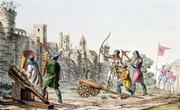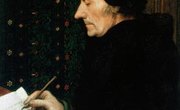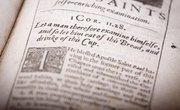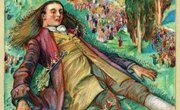The most helpful way to approach English literature is by creating a chronological overview into which you can fit specific trends, works, authors and ideas. By first mastering a basic chronology of English literature, recognizing the new types of literature that emerge in each time period and fitting in specific authors, works and topics, you lay a solid foundation on which to build a growing understanding.
Building the Timeline
English literature begins with the Anglo-Saxon, or Old English, period, which began approximately 410 A.D. when the Romans withdrew from Britain, leaving it to Germanic and Scandinavian settlers. The Old English period ended with the Norman invasion of 1066, when French became the language of the educated classes, gradually blending with Anglo-Saxon to produce Middle English, best known as the language of Geoffrey Chaucer. Middle English gave way to modern English during the Middle Ages, and Britain produced many great authors during the 16th and 17th centuries.
The 18th century is famous for its essayists and satirists and for the appearance of the novel and its precursors. The decades that ended the 18th century and opened the 19th ushered in the British Romantic period, and the works of the Romantic poets. The 19th century is considered the great age of the novel. The turn of the 20th century saw the rise of modernism, a movement characterized by stylistic experimentation and the questioning of traditional values.
Important Trends
In the Old English period, epic poetry, which began as an oral art, was exemplified in "Beowulf." The period is also known for its beautiful elegies, including "The Wanderer" and "The Seafarer." Old English poetry is alliterative, rather than rhyming, and is known for its use of the kenning, a compressed metaphor such as whale-road or night-stalker. In the Middle English period, medieval romances, such as the tales of King Arthur, were popular.
The important trends of the 18th century were the growth of the essay and the satire and the earliest examples of the novel, a long prose narrative with realistic setting and three-dimensional characters. As the 18th century gave way to the 19th, the Romantic movement, which emphasized nature and emotion, produced great poetry such as that of William Wordsworth, Lord Byron and John Keats. After the triumph of the novel form in the 19th century, the Modernists introduced important stylistic innovations such as stream of consciousness, the unreliable narrator, and stories driven more by psychology than by external plot.
Important Authors and Titles
The most famous example of Old English literature is the anonymous epic "Beowulf." The most famous work in Middle English is "The Canterbury Tales" by Chaucer. Although he had many famous contemporaries, William Shakespeare is the best known author of the Elizabethan period. John Milton, known for his epic poem "Paradise Lost," and John Bunyan, author of Pilgrim's Progress, are important names from the 17th century. In the 18th century, such authors as Daniel Defoe, with his Robinson Crusoe, Jonathan Swift, with his Gulliver's Travels, and Henry Fielding, with his Tom Jones, laid the groundwork for the rise of the novel, while Samuel Johnson, Joseph Addison and Richard Steele developed the essay into an influential and widely popular art form.
Themes and Ideas
The major concerns of English literature evolved along with the literary forms that sought to capture them. Anglo-Saxon poetry reflected the transition from traditional pagan beliefs to Christian ideas, and the struggle to blend the two into a new worldview. The medieval romance captured the new concerns and ideals of feudalism, including courtly love, courtesy and chivalry. Herbert Spenser, Shakespeare, Milton, Bunyan and others explored the implications of England's Protestant reformation, and sought to create a distinctively Protestant tradition in English literature.
The characteristic concerns of the Age of Enlightenment, including justice, politics, science, technological progress and education, appeared in the essays and satires of the 18th century. With the novel, a new emphasis on realism and specificity, and a new interest in exploring the characters' development, choices and relationships, appeared in English literature. Most English novels during the 19th century used one or more stories of love and courtship as vehicles to explore such issues as the rise of the middle class, the obligations of the higher classes to the lower, and the need for reform in English society. Poetic justice or an ending, in which the values of the community are reaffirmed and characters seem to get what they deserve, was typical of the endings of most of these works. In contrast, the Modernists were concerned with the uncertainty and complexity of the postwar world, and were heavily influenced by Sigmund Freud's ideas about sexuality and the unconscious.
Related Articles
References
Writer Bio
Shandi Stevenson is a teacher, tutor and author whose work has appeared in national and international publications including "Shibboleths," "Homeschooling Today," and "Resort Living." She holds a Bachelor of Arts in literature in English and a Master of Arts in humanities.











